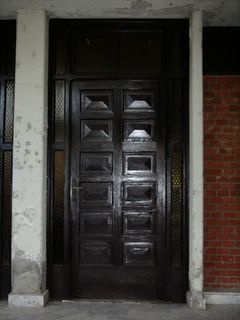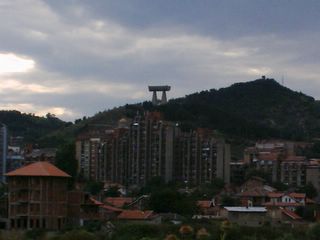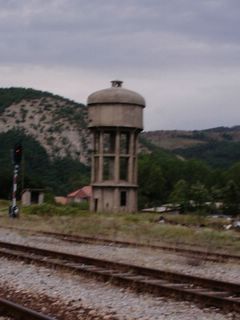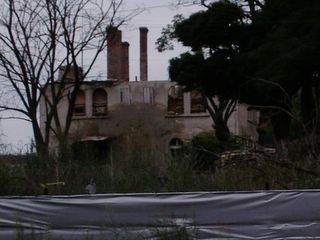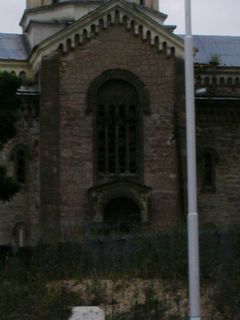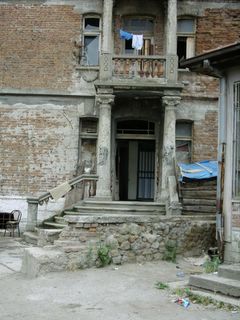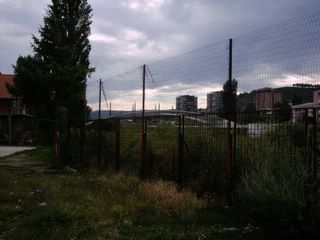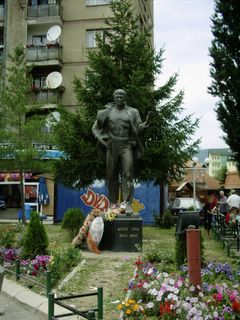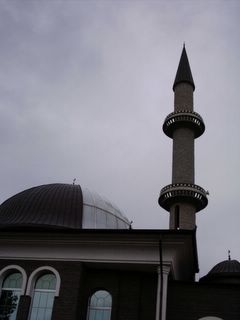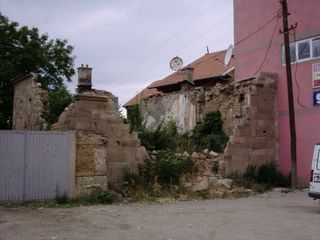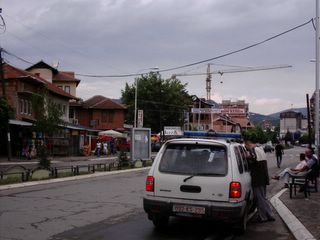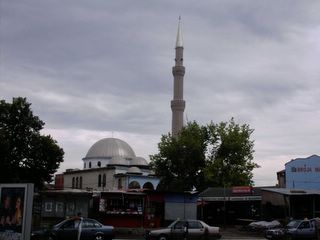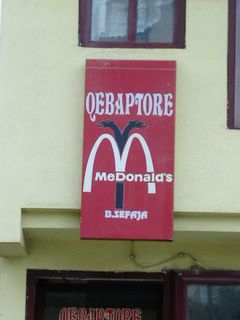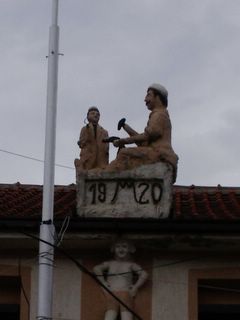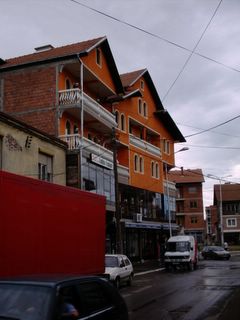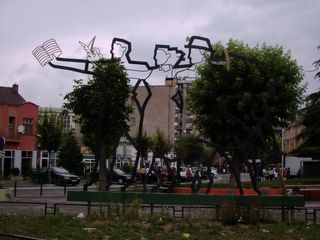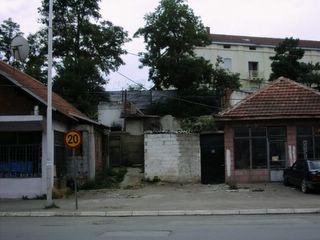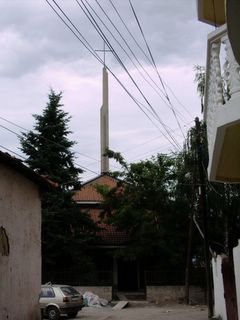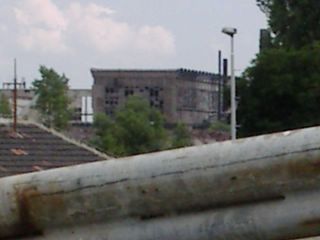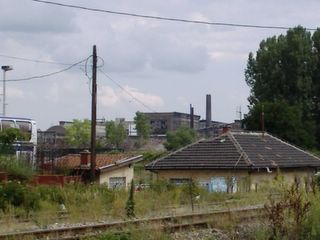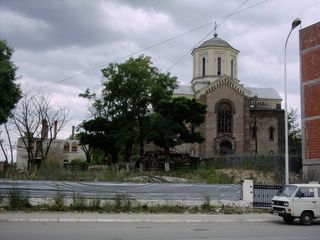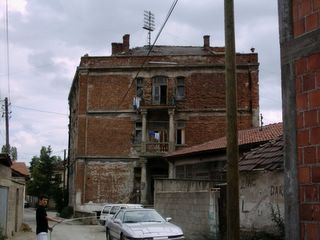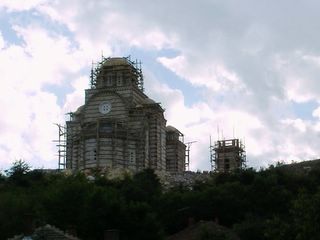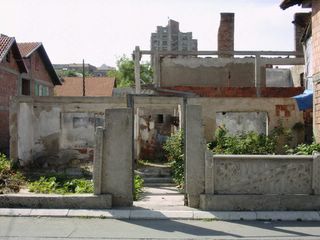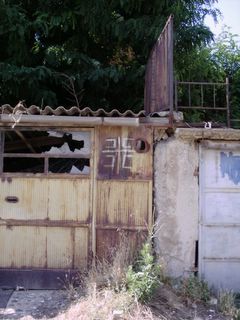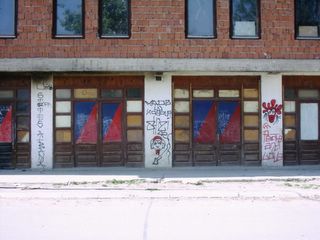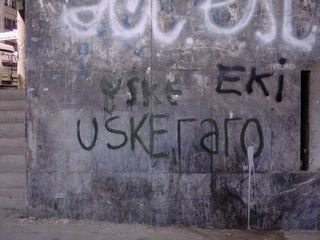
North Mitrovica political art 9: I think this banner reads, "Postujte Rezolutsiju 1244: Povratak Crbskevojske i Politsije", "Respect Resolution 1244: Return Serbs and the Police".
Currently, Soren Jessen-Petersen, the head of UNMIK, says that "on the
standards linked to minority issues there are problems. On the return of refugees, for example, there has been an insignificant number of returns. On freedom of movement, we still have a problem where more than 20% of people say they don't feel they can move freely".
He also says, "on the other hand", that, "institutions are improving, there has been progress in the rule of law, we have a fairly good local Kosovo police service". Correctly, in my opinion, he judges that "the real improvement will only come with status".
The returns programme is failing and that is because the potential returnees do not have the security necessary; part of the reason they don't have the security necessary is the behaviour of some of the members of the Kosovo Police Service (KPS) and the Kosovo Protection Corps (KPC), a successor organisation to the Kosovo Liberation Army (KLA), which has a controversial, intermittent role in emergency responses.
[The other part of the reason is, of course, the behaviour of some of the members of the community, which creates the need for the KPS and the KPC to intervene in the first place, but here I wish to focus on those tasked with establishing and maintaining community security.]
Human Rights Watch has observed that "Some members of the
KPC have been implicated in human rights abuses against minority communities in Kosovo, and involvement in organized crime". The units comprised of the local ethnic majority, the staff poorly equipped and poorly rewarded, the KPS struggle to fulfil their mandate; compounding this, there is such distrust between the KPS and the other institutions, crucially KFOR, that sometimes they may not act effectively.
It may be worth giving some examples of the security problems caused by some members of the Kosovo Police Service, from last year, when incorrect rumours about the causes of some Albanian children's deaths in Mitrovice on the 16th of March 2004 led to riots across Kosovo. These were all taken from a (2004)
Human Rights Watch report on the violence.
When Finnish KFOR and local KPS faced riots in Kisa in Lipljan/Lipjan on the 17th of March 2004, "KPS officers remained passive until two hand grenades exploded, one in the churchyard and another in the yard of a neighboring home."
"Almost immediately, the KPS officers moved to arrest the Orthodox priest and his neighbor, accusing them of throwing the hand grenades, even though both were bleeding from wounds received from the grenades and told the KPS the hand grenades had been thrown by the Albanian crowd".
In Bestin in Lipljan/Lipjan, Joka Vesic relayed to Human Rights Watch, that "the KPS officers didn't take an active part, but they also didn't stop them. There was no KFOR or UNMIK presence."
As Human Rights Watch noted, not only ethnic Serbs, but "Roma, Ashkali (Albanian-speaking Roma), and other non-Albanian minorities also faced violence". It is also important to note that, in Vucitrn/Vushtrii, "even though Vucitrn is in close proximity to two major French KFOR bases - 'Belvedere' and Novo Selo - KFOR or UNMIK did not take an active part in the defense of the Ashkali community".
In the end, "while some KPS officers assisted in the evacuation of Ashkali residents, it appears that other KPS officers played an active part in the violence, arresting and abusing Ashkalis who attempted to defend their homes. According to some Ashkali, some KPS officers participated in the burning of Ashkali homes."
Abdush Cizmolli, the Ashkali village leader, declared that, "'nobody is more to blame than KFOR and UNMIK. If they wanted to, with one tank they could have saved us—it would not have come to all these problems'". French KFOR soldiers explained that "the Ashkali community was 'militarily indefensible'" and that most of them were defending northern Mitrovica.
Human Rights Watch commented that, "KFOR contingents tend to see their engagement in traditional military terms rather than in more appropriate policing terms. In the case of Vucitrn, it is unlikely that KFOR would have had to militarily engage the largely unarmed Albanian crowd by opening fire or otherwise."
They recommended instead that, "crowd control tactics commonly used by civilian police could have had a significant impact" and that "the Ashkali community in Vucitrn was easily defensible from a crowd control perspective". Evidently, not only the KPC and the KPS, but also KFOR, need to be reformed, to ensure the security of all the citizens of all the communities of Kosovo.
[Updated on the 8th of December 2005]

